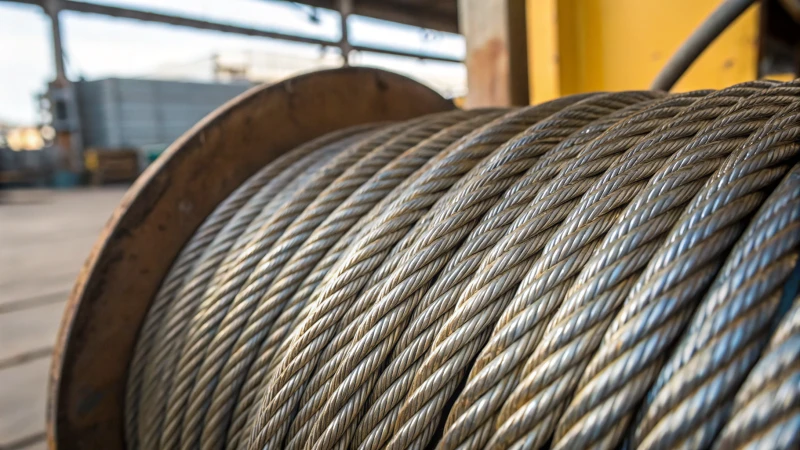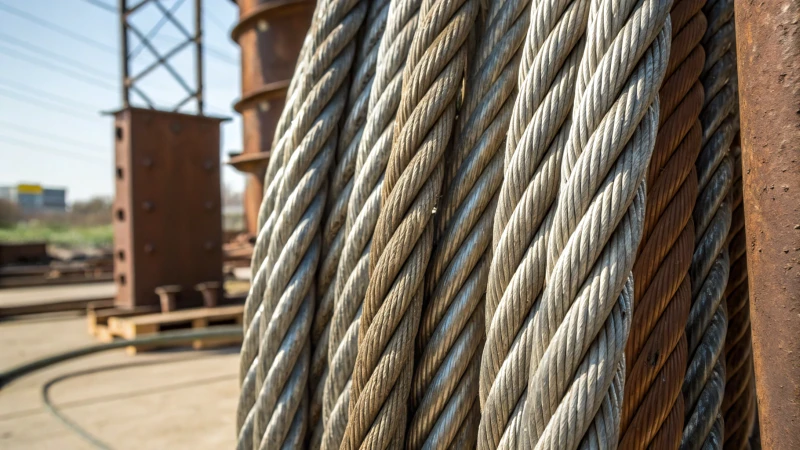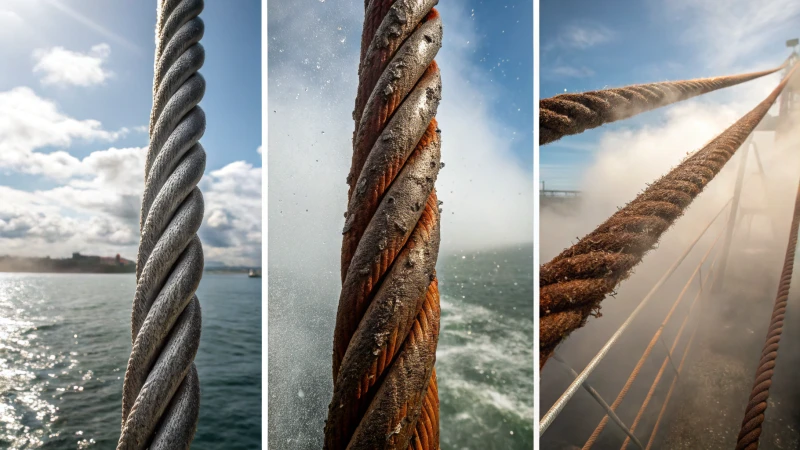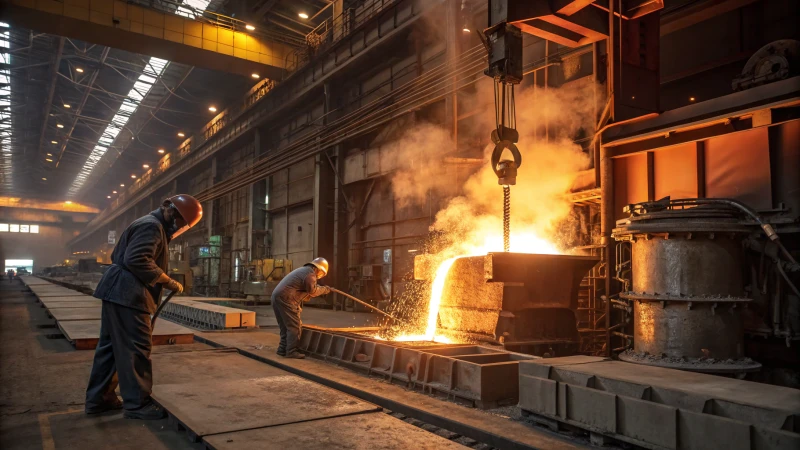
Ever wondered what makes steel wire rope so strong? It's more than just metal and wires!
The tensile strength of steel wire rope depends on material composition, construction method, and heat treatment. Using high-quality alloy steel and modern manufacturing techniques enhances its durability.
I remember the first time I saw a massive crane hoisting heavy beams at a construction site. My mind couldn't wrap around how those thin strands of wire could handle such weight without snapping. That's when I learned about the intricate factors that contribute to the strength of these ropes. Each component, from the choice of materials to the precise methods used in their construction, plays a crucial role. Advanced heat treatments further bolster their resilience, ensuring they withstand tremendous forces. It's like crafting a perfect recipe—every ingredient and step counts towards achieving that robust tensile strength.
Heat treatment processes affect steel wire rope strength.True
Heat treatment alters the microstructure, enhancing tensile strength.
Material composition has no impact on wire rope durability.False
Material composition is crucial for determining strength and longevity.
How Does Material Composition Impact Wire Rope Strength?
Ever wonder how the materials in wire ropes make all the difference in strength and reliability? Let's dive into what makes them tick.
Material composition plays a pivotal role in wire rope strength by influencing tensile properties and durability. Incorporating alloy steel, heat treatment, and composite materials can significantly enhance performance to meet diverse industrial needs.

The Role of Alloy Steel in Wire Rope Strength
I remember the first time I had to choose a wire rope for a big project, feeling overwhelmed by the options. Then, I discovered the magic of alloy steel. By adding elements like manganese and chromium, alloy steel ramps up the tensile strength and durability1 of wire ropes, making them perfect for high-load tasks.
Heat Treatment Processes
You know, I’ve always found it fascinating how something as complex as heat treatment can transform wire ropes. Through processes like annealing and quenching, the steel's microstructure changes, boosting hardness and wear resistance.
| Process | Effect |
|---|---|
| Annealing | Enhances ductility |
| Quenching | Increases hardness and strength |
Composite Materials: The Future of Wire Ropes
When I stumbled upon composite materials, it felt like discovering a whole new world. Imagine using Kevlar and carbon fibers instead of traditional steel—these composites can offer similar or even superior performance but with less weight. They're a game-changer in industries where weight matters, like maritime operations.
Comparing Material Impact on Tensile Strength
Each material impacts tensile strength differently. Here’s a quick comparison:
| Material Type | Tensile Strength Impact |
|---|---|
| Standard Steel | Baseline strength |
| Ultra-high-strength Steel | 15%-25% higher than standard steel |
| Composite Materials | Varies, often lighter yet strong |
Choosing the right wire rope isn’t just about strength; it's about matching the material to your operation's specific demands. From load capacity to environmental conditions and cost, each factor matters. Dive deeper into this topic with our in-depth analysis2 to make informed decisions.
Alloy steel increases wire rope tensile strength by 20%.True
Alloy steel, with elements like manganese, enhances tensile strength significantly.
Composite materials are heavier than standard steel ropes.False
Composite materials like Kevlar are lighter while maintaining strength.
How Does the Construction Method Affect Wire Rope Performance?
Ever wondered why some wire ropes perform better than others? Dive into the heart of their construction to find out!
The construction method of wire ropes significantly impacts their performance by influencing tensile strength, flexibility, and durability. Factors such as the number of strands, core type, and lay direction play critical roles.

Influence of Stranding Patterns
I've always been fascinated by how the simplest things can make the biggest difference—like the way wire ropes are constructed. Think of wire ropes like a finely braided friendship bracelet, where each twist and turn adds to its overall strength and flexibility. The stranding patterns in these ropes are no different. They determine how well the rope can withstand wear and tear or adapt to bending stresses.
- Seale: Imagine a robust outer shield; that's what larger outer wires provide—abrasion resistance3 perfect for those gritty jobs.
- Warrington: This pattern, with its alternating wire sizes, feels like a friend who's both flexible and supportive when you need it most.
- Filler Wire: It's like filling in the blanks with small but mighty reinforcements that add strength in unexpected ways.
Each pattern offers unique advantages depending on the application, with Seale being preferred in high-abrasion scenarios and Warrington in situations requiring flexibility.
Core Types: Steel vs. Fiber
Choosing between a steel or fiber core in a wire rope is like choosing between a reliable old friend and a new acquaintance with fresh ideas. Steel cores remind me of those friends who are always there when you need them—strong and crush-resistant. Perfect for heavy-duty tasks like lifting in construction4. On the other hand, fiber cores offer flexibility and lightness, kind of like that spontaneous friend who suggests fun, cost-effective adventures.
| Core Type | Benefits |
|---|---|
| Steel | High strength, crush resistance |
| Fiber | Flexibility, lightweight, reduced cost |
Steel cores are ideal for heavy-duty tasks like lifting in construction5, whereas fiber cores suit applications where flexibility is paramount.
Lay Direction and Its Impact
The direction in which strands are laid is crucial. I remember once choosing a regular lay rope for a project because it promised better resistance to untwisting—a decision that paid off by keeping everything steady even when tensions ran high.
- Regular Lay: The strands run parallel to the rope's axis, offering better resistance6 to untwisting—perfect for maintaining harmony under pressure.
- Lang Lay: With strands at an angle, there's more surface contact which translates into increased wear resistance—a bit like how some friendships grow stronger the more they're tested.
Understanding these construction elements is like assembling a toolkit for life; it equips you with knowledge to make informed choices tailored to your specific needs. Whether you're selecting a rope for its strength or its ability to adapt to different conditions, knowing these details ensures you're ready for whatever task comes your way.
Seale pattern enhances wire rope flexibility.False
Seale pattern provides abrasion resistance, not flexibility.
Fiber core ropes are more flexible than steel core ropes.True
Fiber cores offer greater flexibility compared to steel cores.
How Do Environmental Conditions Affect Steel Wire Ropes?
Ever wondered how a seemingly simple thing like weather can affect something as robust as steel wire ropes? It turns out, the environment plays a big role in their lifespan.
Environmental conditions, such as moisture, temperature shifts, and corrosive agents, can significantly impact steel wire ropes by hastening wear and tear, diminishing tensile strength, and increasing corrosion risk. Regular maintenance and protective coatings are essential to counteract these effects.

I remember the first time I realized just how much the environment could affect steel wire ropes. We were on a construction project near the coast, and I noticed the ropes were starting to rust much faster than expected. That salty sea air was not our friend! It was a lesson in how crucial it is to understand the environmental conditions where these ropes are used.
Impact of Humidity and Moisture
Humidity is sneaky—it can lead to moisture buildup on steel wire ropes, upping the chances of corrosion. I learned this the hard way when working in a tropical climate where rain seemed more like a daily ritual. That's when I found that using ropes with galvanized coatings7 can be a lifesaver, shielding them from rust.
| Environment | Corrosion Risk |
|---|---|
| Dry | Low |
| Humid | High |
| Marine | Very High |
Effects of Temperature Fluctuations
Temperature changes can be tricky. I recall a winter project where the ropes became brittle due to extreme cold—thankfully, we switched to heat-treated8 wire ropes just in time to prevent a disaster. These fluctuations make steel wires expand and contract, causing material fatigue.
Saltwater and Corrosive Environments
Saltwater is brutal on steel wire ropes. During my time on a maritime project, I quickly realized that stainless steel9 ropes are worth the investment. They resist rust better, and regular inspections became our best friend to catch early wear signs.
Protective Measures and Maintenance
Implementing protective measures, like applying lubrication or using plastic coatings10, can extend the lifespan of steel wire ropes. These create a barrier against environmental elements, slowing down deterioration.
Regular maintenance became a routine for us—cleaning to remove corrosive agents like salt deposits and inspections to address wear or damage promptly. A scheduled maintenance plan helped us keep ropes in optimal condition.
| Maintenance Task | Frequency |
|---|---|
| Cleaning | Monthly |
| Inspection | Quarterly |
| Lubrication | Bi-Annually |
By understanding the specific environmental challenges your application faces, you can select the right materials and maintenance strategies to enhance the longevity and performance of your steel wire ropes. It's all about adapting to what Mother Nature throws at us.
Humidity increases corrosion risk for steel wire ropes.True
Humidity leads to moisture accumulation, increasing corrosion risk.
High temperatures strengthen steel wire ropes.False
High temperatures reduce tensile strength of steel wire ropes.
How does heat treatment enhance tensile strength?
Ever thought about the magic behind making metals stronger and more durable? Heat treatment is the secret ingredient!
Heat treatment is essential for enhancing tensile strength because it modifies the microstructure of metals, boosting their resistance to deformation under stress and making them more robust for industrial uses.

Understanding Heat Treatment Processes
I remember the first time I saw the power of heat treatment at work. Watching a simple piece of metal transform into something far stronger was like witnessing a kind of industrial alchemy. Through controlled heating and cooling, metals undergo changes in their physical and mechanical properties, all while keeping their original shape intact. It's fascinating how something as simple as adjusting temperatures can drastically improve tensile strength11, toughness, and hardness.
Types of Heat Treatment:
- Annealing: This process is like giving the metal a relaxing spa day, relieving internal stresses and enhancing ductility.
- Quenching: Imagine taking a hot metal and plunging it into cold water. It's a rapid cooling technique that toughens the metal.
- Tempering: After quenching, tempering helps reduce brittleness, striking a balance between hardness and flexibility.
Each method brings its own twist to enhancing tensile strength. It's like choosing the right tool for a job—each has its place based on what you need the metal to do.
Microstructural Changes
Diving deeper into the science, it's the microstructure of a metal that sets the stage for its mechanical properties. When I first learned about how grain size and phase distribution are altered through heat treatment, it was like discovering the secret recipe for strength. For example, in steels, quenching turns austenite into martensite, giving it a significant boost in tensile strength12. Check out this simple table that breaks it down:
| Process | Effect on Microstructure |
|---|---|
| Annealing | Refines grain size |
| Quenching | Forms martensitic structure |
| Tempering | Balances hardness and ductility |
These transformations are crucial for materials used in heavy-duty applications like construction and machinery, where load-bearing capability is everything.
Industrial Applications
In industries such as mining and construction, where materials face extreme forces, heat-treated steel wire ropes are vital. I recall a project where we switched to heat-treated ropes and saw tensile strengths jump by up to 25%. It was a game-changer for our heavy machinery operations. For procurement managers like me, understanding these processes means sourcing materials that don't just meet standards—they exceed them. It ensures safety, reliability, and longevity in demanding environments.
Explore more on heat treatment techniques13 to harness their full potential.
Annealing improves ductility in metals.True
Annealing relieves internal stresses, enhancing the metal's ductility.
Quenching decreases the hardness of metals.False
Quenching increases hardness by forming a martensitic structure.
Conclusion
The tensile strength of steel wire rope is influenced by material composition, construction methods, heat treatment, and environmental conditions, ensuring durability for heavy-duty applications.
-
Explore how alloy steel components enhance the durability and longevity of wire ropes. ↩
-
Learn more about how to choose the optimal material composition for specific industrial applications. ↩
-
Explore how Seale patterns enhance abrasion resistance in wire ropes. ↩
-
Discover why steel cores are preferred for heavy-duty lifting applications. ↩
-
Discover why steel cores are preferred for heavy-duty lifting applications. ↩
-
Learn how regular lay provides better resistance to untwisting. ↩
-
Galvanized coatings provide a protective layer that reduces rust and corrosion, extending the life of steel wire ropes in humid environments. ↩
-
Heat-treated steel wire ropes offer enhanced durability and performance in fluctuating temperatures, preventing brittleness and strength reduction. ↩
-
Stainless steel wire ropes are highly resistant to rust and corrosion, making them ideal for marine applications where exposure to saltwater is prevalent. ↩
-
Plastic coatings protect steel wire ropes from environmental elements, reducing wear and tear while extending their operational lifespan. ↩
-
Clicking this link provides insights into how tensile strength influences material selection in various industries. ↩
-
This link explains the transformation of microstructures during quenching, crucial for enhancing tensile strength. ↩
-
Learn about different heat treatment methods and their applications in enhancing material properties. ↩

